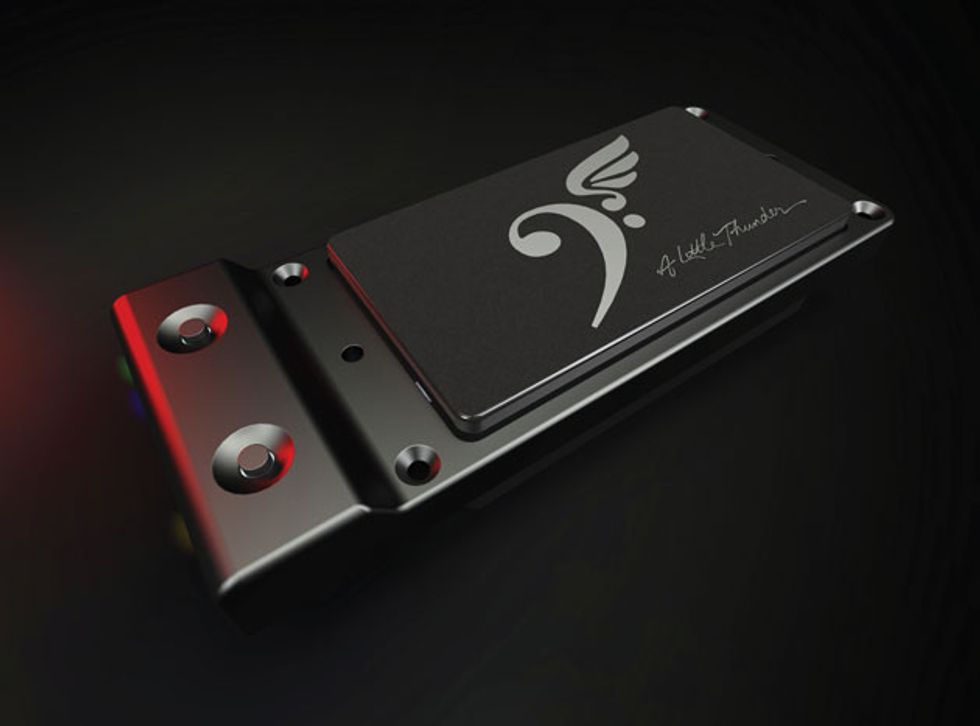Try these tips to navigate your way out of a playing rut.
A Little Thunder is a new pickup that gives guitarists the ability to simultaneously send both a bass and guitar signal from a single instrument. It’s a super fun way to experiment with tone.
It happens to all of us. Whether it’s a tone thing, a playing thing, songwriting, or perhaps something to do with our gigging or studio situations, we get creatively stuck from time to time. Let’s explore some of the simple things we can do to break the cycle of the mundane and get inspired again.
Playing ruts. Do you ever find yourself playing the same old licks, chords, and songs over and over? Thanks to modern tech, it’s easier than ever to get inspired and find our way out of playing ruts. The advent of YouTube means there are seemingly limitless options for lesson material right at our fingertips. There’s also a myriad of terrific online lessons and courses available from sites like jamtrackcentral.com and truefire.com. An endless well of inspiration is literally a click away.
With YouTube, I suggest making playlists to organize the lessons you come across and like into different categories, with titles such as Blues Guitar Practice, Technique, Cool Licks, or whatever works best for you. They’ll be much easier to find later on if you keep them organized. Get yourself a portable audio interface so you can plug in to your laptop, phone, or tablet wherever you are and jam along with your favorite lessons and tracks.
Speaking of jam tracks, I sometimes get stuck in a rhythmic rut. When I pick up the guitar to play or write, it’s natural to gravitate towards familiar tempos or rhythmic patterns. When I catch myself doing this, I’ll switch it up by jamming along to songs, grooves, or jam tracks that are a total departure, both in tempo and rhythm.
For example, if I’ve been playing lots of straight-ahead eighth-note rock rhythms at fast tempos, I might pull up Led Zeppelin’s “D’yer Mak’er” and just loop four measures of the groovy reggae-inspired intro. I’ll jam along and improvise for 20 minutes or so, and before long, I’m in a whole new headspace. Phrase-trainer programs like Transcribe! or Riffstation are terrific tools for looping sections of songs so you can jam along.
If you’re a blues player and you find yourself tiring of mid-tempo, bouncy 1-4-5 tunes, put on a track like ZZ Top’s “Blue Jean Blues” and get into the minimalist, super-slow and minor-tinged blues vibe. It’s simple and sparse, but not easy. All of a sudden, your minor-to-major-third bends won’t work, and you’ll have to come up with new ways to resolve your tried-and-true blues licks.
I took a private lesson with Paul Gilbert a few years ago and he gave me some great advice for inventing new licks. He suggested that I think about classic-rock drum grooves and fills that I liked, and then use those as the rhythmic basis for a lick. For example, take the awesomely epic fill that happens in Phil Collins’ “In the Air Tonight” shortly after the 3-minute mark. Now, simply come up with a guitar lick that mimics that rhythm. You’ll more than likely find yourself playing licks and riffs that totally differ from whatever your norm is.
Tone ruts. If you’re like me, you naturally gravitate toward certain gear for certain musical situations. Let’s say I’m doing a recording session for a rock artist. My first instinct for a hard-rock song is that I’ll need a Marshall-type amp with a closed-back cabinet and a guitar with a humbucker in the bridge. While it’s good to have a perspective on tonal “home bases,” if you always gravitate to the same gear for particular styles, you run the risk of sounding formulaic and predictable. Don’t be afraid to mix it up, in small and big ways.
An example of a small deviation would be adding a pedal to your rig that you might not normally use. In a hard-rock context, a treble booster could be a cool choice. Many of the early Judas Priest recordings featured Marshall amps pushed with a Dallas Rangemaster treble booster for a searing distorted tone. So instead of trying to get a heavy sound by diming the preamp gain on a modern amp, I might run the amp gain halfway and hit it with a treble booster. When I approach tone like this, I find myself coming up with less-homogenized guitar sounds.
A larger deviation to achieve a hard-rock tone would be trying something out of the norm altogether. An AC30, Supro, or Silvertone combo amp with a cool fuzz in front could be just the ticket. Guitarists like Jack White and Matt Bellamy have thrown out the hard-rock-tone rulebook by using unconventional rigs to great effect. Let’s take it a step even further …
My friend Andy Alt has developed a new replacement pickup called “A Little Thunder” that essentially allows you to add a bass sound to your guitar signal. The 5th and 6th strings are run through an onboard DSP to shift the pitch down either one or two octaves. The “bass” strings can then be blended out the standard 1/4" output with the other strings, or even cooler, they can be sent out their own output to a separate bass rig. Just imagine the possibilities with a distorted, possibly fuzzed or treble-boosted guitar amp for the top four strings, a thundering bass amp for the 5th and 6th strings, and different effects pedals on each output. The sky’s the limit!
It’s never been easier for guitarists to find new rut-busting inspiration. Until next month, I wish you nothing but good tone.

